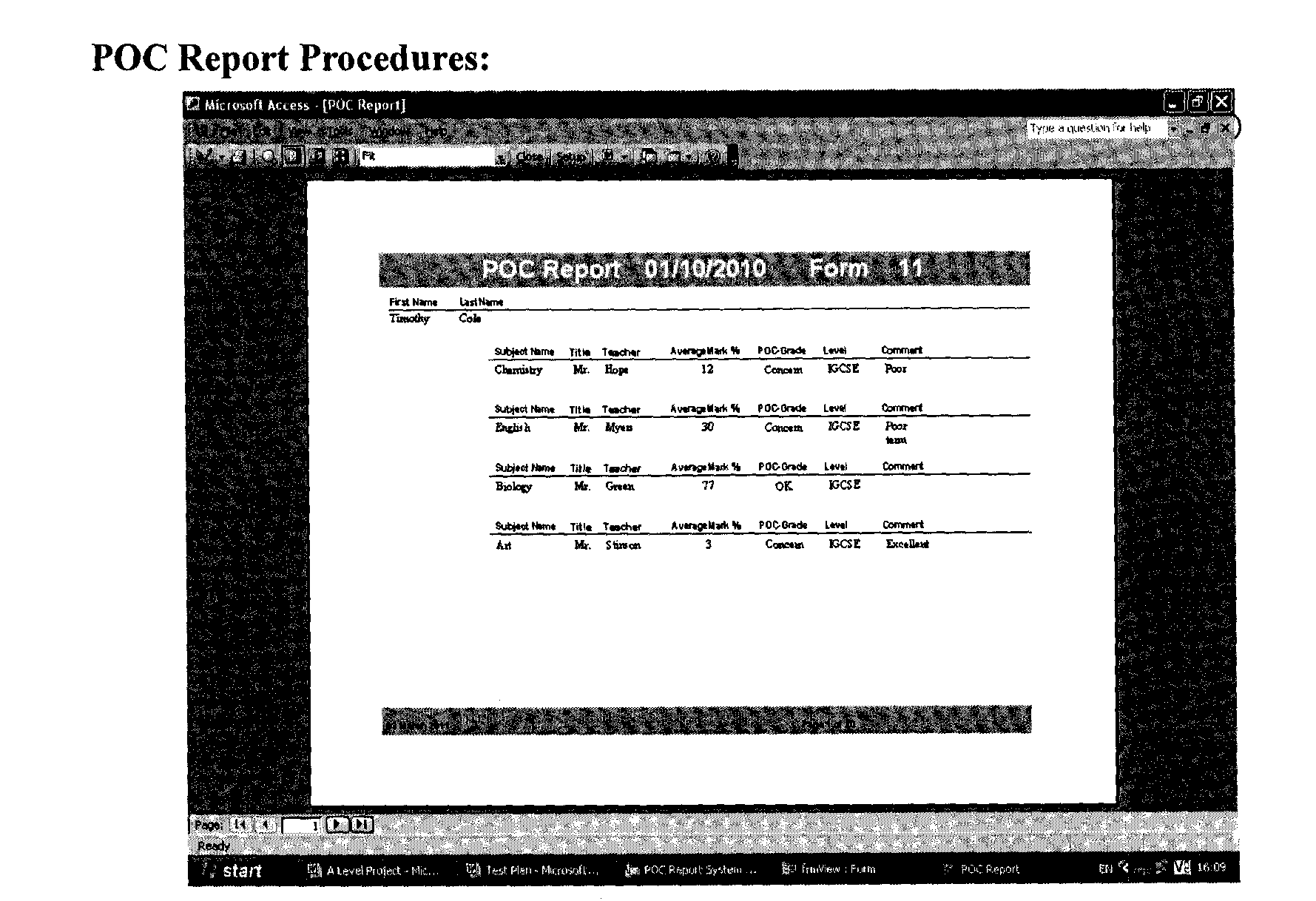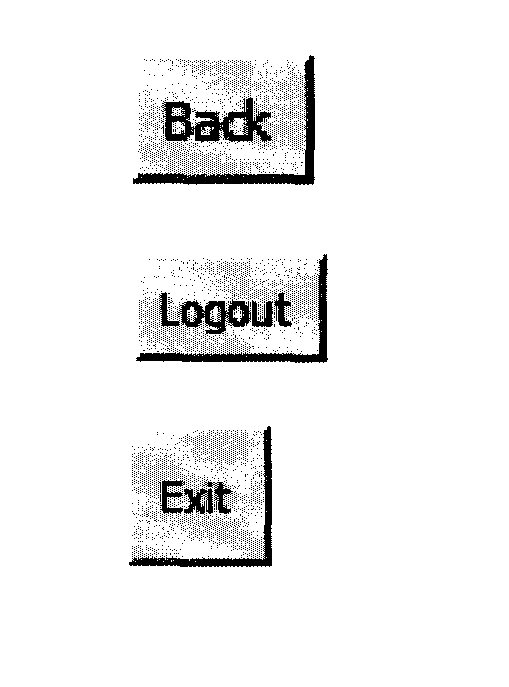
- •Integrated Programme of Development
- •What is the Project?
- •Choosing a Suitable Project
- •Complexity
- •3.1 Complexity examples
- •Methodology
- •Guidance on marking the Project
- •Examples of marked candidate responses
- •6.1 Quality of report [Total 3 marks]
- •6.2 Definition, investigation and analysis [Total 11 marks]
- •Quality of report
- •Introduction
- •Quality of report
- •Quality of report
- •Investigation:
- •6.3 Design [Total 12 marks]
- •Nature of the solution [8 marks]
- •Quality of report
- •Intended benefits [2 marks]
- •Limits of the scope of the solution [2 marks]
- •6.4 Software development, programming, testing and installation [Total 18 marks]
- •Development [4 marks]
- •Programming [5 marks]
- •Installation [4 marks]
- •Installation Plan
- •6.5 Documentation [Total 10 marks]
- •Systems maintenance documentation [4 marks]
- •Quality of report
- •6.6 Evaluation [Total 6 marks]
- •Discussion of the degree of success in meeting the original objectives [3 marks]
- •Quality of report
- •Evaluate the client’s and user’s response to the system [3 marks]
- •Quality of report
6.5 Documentation [Total 10 marks]
Systems maintenance documentation [4 marks]
Much of the documentation will have been produced as a by-product of design and development work and also as part of writing up the report to date.
The contents of the guide should, where relevant, include the following:
record, file and data structures used;
data dictionary;
data flow (or navigation paths);
annotated program listings;
detailed flowcharts;
details of the algorithms used
adaptive maintenance to provide for some future proofing
All parts of the guide should be fully annotated, since this is important for subsequent maintenance of the system.
The specifications of the hardware and software on which the system can be implemented should be included.
Example 10: Candidate response from Garden Centre project, the mark and comments given by the teacher on the marking grid with examiner comments and notes.
Quality of report
(i) Systems maintenance documentation [_4_/4 marks]
|
Mark |
Comments |
|
1-2 |
Some items are present with some annotation attempted. |
|
Teacher’s comment – all sections present. Examiner’s comment – cross referencing is used sensibly so that all items can be found. |
3-4 |
One or two omissions, but the rest is present and annotation is used sensibly. |
4 |
|
Examiner Comment: Candidates do not need to duplicate evidence in their reports; this candidate’s systems maintenance section makes reference to items elsewhere in the candidate’s report this is acceptable or a candidate can put the required elements in the systems maintenance document and make reference into that section.





Section References
Most of the sections required for the system maintenance documentation already occur previously in this document:
Section |
Page reference |
Record, File and Data structures |
25-29 |
Data Flow Diagram |
24 |
System Component Breakdown Diagram |
22 |
Form Navigation Diagram |
33 |
Process Model |
23 |
Annotated Program Listings (code) |
67-87 |
Algorithms |
34-37 |
Hardware and Software required |
19-20 |
Possible Adaptive Maintenance
To further improve the system, future work and updates could include: • Connecting the database to the internet
Connecting to the database via a smart phone
Better sorting of data in cboclt, cboheight and cbocirc on frminput
Use an input mask on cboclt and cboheight for added data consistency
The ability to sort records on frmmain by different fields
Have the ability to decide how to sort files on a report
Have the ability to decide what data will be included on a report by using a search
Be able to store more than one photo per offer
The system could be made with larger objects and with larger windows so it doesn't appear too small/illegible on a high resolution monitor
Back-Up Procedure
Storage Media
To back-up the system, use 4 USB flash drives with a least 4 GB of free space on each.
Two of the drives will be used to make daily back-ups
Two of the drives will be used to make weekly back-ups
Storage Media Use
The two daily drives should be updated every other day, but separately from each other. Eg. Drive 1 should be backed-up on day 1, followed by drive 2 on day 2, then drive 1 on day 3 and drive 2 on day 4 etc.
The two weekly drive's back-up should be updated at the end of each week, working on a similar rotation pattern as the daily drives but using weeks instead of days.
(ii) User documentation [6 marks]
Clear guidance, as friendly as possible, should be given to the user for all operations that they would be required to perform.
These would include input format with screens displays, print options, back-ups (file integrity routines), security of access to data and a guide to common errors that may occur. (Note: the candidate would not be required to copy out large volumes of any underlying software’s user guide, but to produce a non-technical and easy to follow guide for someone with little computer knowledge.)
Some mention here of the relationship between items of software and the data they deal with may be relevant.
The user guide should be well presented with an index and, where necessary, a glossary of the terms used.
Alternatively, an electronic guide could be based around hypertext links (screen dumps will be required).
Example 11: Candidate response from Pupil Record system project, the mark and comments given by the teacher on the marking grid with examiner comments and notes.
Quality of report
(i) User documentation [_5_/6 marks]
|
Mark |
Comments |
|
1-2 |
An incomplete guide, perhaps with no screen displays. Some options briefly described but difficult for the user to follow. |
|
Teacher’s comment – a full user guide with all options included but descriptions could have been more detailed. Examiner’s comment – clear user guide with all options included but description lacking in places e.g. backing up to a USB drive. |
3-4 |
All but one or two options fully described (for example, back-up routines not mentioned). In the main the options are easy for the user to follow with screen displays. |
|
|
5–6 |
A full user guide with all options described well presented (possibly as booklet) with an index and a glossary. No omission of any of the options available (including back-up routines, guide to common errors). Marks may be lost for inadequate descriptions of some options. For full marks, good on-screen help should exist, where this is a sensible option, and be present in the form of a hypertext document. |
5 |
|
User Manual
(All possible errors will be displayed in the common error guide below)

1. Enter username and password in respective fields (see diagram above)
Default username will be teacher's name followed by the first letter of their last name
Default password will be the first word of the subject taught
Contact administrator for password alteration or retrieval
2. Click the Logon button when both fields have been filled in

Click the button labeled View or Create POCs in order to open the respective POC view or POC creation forms
 1.Editing
Existing POCs
1.Editing
Existing POCs
a) Select a previous POC date from the list box labeled date (see diagram above)
b) Select the academic level of the student for which the POC should be edited
c) Select the name of the student for which the editing is wanted
d) Select the grading fields in need of change and replace the desired values
2. Creating New POCs
a) Select a new POC date from the list box labeled date
b) Select the academic level of the student for which the POC should be edited from the list box labeled level
c) Select the name of the student for which the editing is wanted from the list box labeled name
d) Select the grading fields and input the desired values

1. Select a POC date from the list box labeled date
2. Click the View Report button to generate reports of the existing POCs for the students in the teacher's tutor group for the selected date
— Individual POCs can be viewed by scrolling through the list box

1. Click print button to open print menu allowing to print multiple or single POCs
2. Click zoom button to increase the report size on screen
3. Click cross to close the report and return to View POCs form
4. Use navigation buttons or arrow keys to navigate through form POCs
Examiner Comment: other procedures were also described in the guide.
Back, Logout and Exit Procedures:
1. Click on the labeled buttons to perform the following procedures
- Back Button: Returns user to the previous form
- Logout Button: Returns user to the login screen enabling other users access
- Quit Button: Shuts down POC Lunch System

On Screen Help
All objects that require input, selection, clicking or any other sort of user interaction have a "control tip text" this will display the objects function if you place your cursor over it for 3 seconds. Examples below list: object type (object name, form location)

 Back-up
Routine
Back-up
Routine
The IT department will be in charge of performing daily backups within the two week period when POCs must be filled out to ensure all data is up to date and secure. An updated copy is always held on the server which all teacher have access to.
Every term a backup is made on the school database to store all term POCs in addition to a yearly backup of the POCs finished that year on a CD that is storage in a separate location.
Two hard copies are printed for each student one to be stored in the student files and one for the tutors use during parent teacher conferences.
Finally it is recommended that teachers keep a copy of the system on a usb key or other external storage device.
Glossary
Default: Settings or values set up when a program is set up
Form: A graphical interface allowing a user to control components and make use of displayed objects
Hardware: A peripheral device that is used with a computer to enable or simplify its operation
List Box: A box used to select data from (can contain a scroll bar if it contains larger amounts of data)
POCs: Grading system used to grade students progress between terms (Praise, OK & Concern)
Query: A method of displaying specified fields in a database system using selected parameters
Record: A data structure which is used to organize data within
Report: A formatted and organized presentation of data (which can be printed) Software: A collection of functions and procedures required to utilize the computer
Index
Back-up 127
Control tip text 125,126
Error Guide 126
Glossary 127
Help 125
Password 122,126
POC 123,124,125
Procedures 122,123,124,125
Report 124,127
save 126
User Manual 121
Username 122,126
